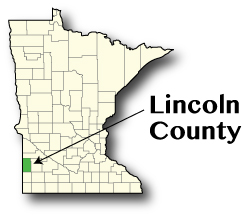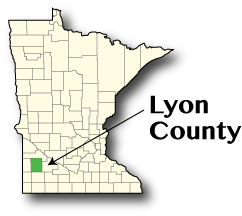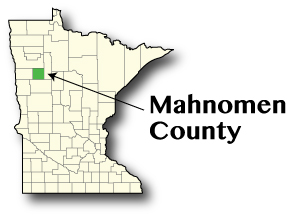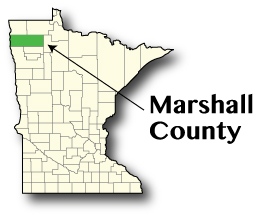by Erik White
December 2017

Lincoln County, named to honor Abraham Lincoln, was established in 1873 in Southwestern Minnesota with Ivanhoe as the county seat, after some debate, since 1904. The Icelandic, Danish, and Norwegian people were the main settlers in the 1800s because they were more suited for the intense cold winter, farming methods, and weather variations. Agriculture and agribusiness has been the main industry for a century. Total farm revenue has increased from $77.3 million in 2000 to $216.7 million in 2013. The county has five incorporated cities and 15 townships.
Lincoln County has lost 25% of its population since the 1970s, and we might see this trend continue. Education and Health Services jobs are likely to continue to decline because of population decreases. However, total construction jobs have increased 43%, and the wages for those jobs increased 84% since 2006. If the trend continues, total crop production will continue growing into the future.
The population of Lincoln County is 5,771, 80th of the 87 counties in Minnesota. The unemployment is similar to the state's. The median household income is about 22% lower than the state, and the cost of living is 20% lower than the state. There is no notable industry or Manufacturing within the County.
| Economy | ||
|---|---|---|
| Estimates | Lincoln County | Minnesota |
| Population 2015 | 5,771 | 5,576,606 |
| Labor Force 2017 | 3,373 | 2,959,248 |
| Average Unemployment | 3.8% | 3.3% |
| Median Household Income | $49,438 | $63,217 |
| Cost of Living, Individual | $25,355 | $29,856 |
| Cost of Living, Average Family | $44,156 | $55,200 |
| Source: DEED Local Area Unemployment Statistics, Cost of Living; U.S. Census Bureau, 2016 American Community Survey | ||
| Industry | ||||
|---|---|---|---|---|
| Top Industries of Employment | Total 2016 Employment | Percent Change 2006-2016 | Average Annual Wages | Percent Change 2006-2016 |
| Total, All Industries | 1,710 | -2.3% | $33,852 | 45.6% |
| Education and Health Services | 554 | -18.6% | $32,864 | 29.2% |
| Trade, Transportation, and Utilities | 411 | -1.2% | $35,880 | 60.1% |
| Construction | 185 | 43.4% | $55,952 | 84.6% |
| Public Administration | 124 | -6.8% | $30,940 | 43.0% |
| Source: DEED Quarterly Census of Employment and Wages 2006-2015 | ||||

Lyon County, named for General Nathaniel Lyon who was killed in the Civil War, was established in 1868 in Southwestern Minnesota as the railroad lines were first built through the county. Marshall is the county seat. Lyon County's employment over the century was mainly in farming. The population has been steady at 25,000 since 1970. The Education and Health Services jobs have seen the only major job increases in the last decade, all of that increase was in Health Services jobs. The Trade, Transportation, and Utilities, Manufacturing, and Professional and Business Services industries have all seen modest decreases in employment over the last decade.
Education employment is likely to stay the same while the Healthcare and Social Assistance industry continues to increase in employment as the population ages. The long term trend in Manufacturing portends increasing wages and decreasing employment.
It is common for Education and Health Services to be the largest employer in a rural Minnesota county. However, it is less common for Manufacturing to be the #3 industry. Manufacturing is the third largest industry and pays wages 26% over the average family's cost of living. The fourth largest employer Professional and Business Services is 32% above the average family's cost of living. These both represent the best places to work based on wages.
| Economy | ||
|---|---|---|
| 2016 Estimates | Lyon County | Minnesota |
| Population | 25,673 | 5,576,606 |
| Labor Force | 15,377 | 2,959,248 |
| Average Unemployment | 2.9% | 3.3% |
| Median Household Income | $51,920 | $63,217 |
| Cost of Living, Individual | $23,588 | $29,856 |
| Cost of Living, Average Family | $41,259 | $55,200 |
| Source: DEED Local Area Unemployment Statistics, Cost of Living; U.S. Census Bureau, 2016 American Community Survey | ||
| Industry | ||||
|---|---|---|---|---|
| Top Industries of Employment | Total 2016 Employment | Percent Change 2006-2016 | Average Annual Wages | Percent Change 2006-2016 |
| Total, All Industries | 14,590 | -2.5% | $40,508 | 28.3% |
| Education and Health Services | 3,623 | 18.8% | $40,612 | 40.2% |
| Trade, Transportation, and Utilities | 3,013 | -13.9% | $33,020 | 11.5% |
| Manufacturing | 2,150 | -4.2% | $51,168 | 48.6% |
| Professional and Business Services | 1,456 | -13.6% | $54,444 | 23.4% |
| Source: DEED Quarterly Census of Employment and Wages 2006-2015 | ||||

The White Earth Indian Reservation was created by an 1867 treaty. Mahnomen County was established in 1907, just after the railroad lines were built through Mahnomen city. Mahnomen is the Ojibwe word for wild rice, a major crop in the county. The reservation makes up the entirety of the Mahnomen County. The land has been rich in soil and timber. Bonanza farms, large farms mostly for wheat, were built in the early 1900s. The county is also noted for Red River Ox Carts used to move animal hides from the northwest part of the state to Saint Paul for shipping to the East Coast. The carts had no grease on the axel and could be heard for a considerable distance.
The Gaming Industry is set to maintain its leading position as the largest employer and distributor of wages for Mahnomen County
The entire county is still within the White Earth Indian Reservation. Leisure and Hospitality make up the largest employer and total wages for the county. The Gambling Industries make up a large majority of that employment and total wages. Education and Health Services are a distance second in employment for the County. Public Administration, which is primarily tribal officials, pays the best wages.
| Economy | ||
|---|---|---|
| 2016 Estimates | Mahnomen County | Minnesota |
| Population | 5,457 | 5,576,606 |
| Labor Force | 2,336 | 2,959,248 |
| Average Unemployment | 4.8% | 3.3% |
| Median Household Income | $41,597 | $63,217 |
| Cost of Living, Individual | $25,724 | $29,856 |
| Cost of Living, Average Family | $44,458 | $55,200 |
| Source: DEED Local Area Unemployment Statistics, Cost of Living; U.S. Census Bureau, 2016 American Community Survey | ||
| Industry | ||||
|---|---|---|---|---|
| Top Industries of Employment | Total 2016 Employment | Percent Change 2006-2016 | Average Annual Wages | Percent Change 2006-2016 |
| Total, All Industries | 1,935 | -7.1% | $33,800 | 31.3% |
| Leisure and Hospitality | 990 | -7.2% | $29,380 | 28.4% |
| Education and Health Services | 343 | -7% | $40,300 | 32.3% |
| Trade, Transportation, and Utilities | 256 | -5.2% | $39,988 | 35.4% |
| Public Administration | 143 | 7.5% | $47,929 | 61.4% |
| Source: DEED Quarterly Census of Employment and Wages 2006-2015 | ||||

Marshall County, named for William R. Marshall, fifth governor of Minnesota who also served in the Civil War as a Brigadier General, was established in 1879. There were few white settlements in this area until railroad lines were built in 1872 and 1873. The railroads brought a wave of immigration, and in about 10 years nearly all the land was taken by homestead and preemption claims. Capitalists bought land and created Bonanza farms of up to 40,000 acres to produce spring wheat to be transported to Minneapolis for milling.1 Agriculture has been the main industry since the 1800s. Since 1970 the population had decreased from approximately 13,000 people to less than 10,000.
Manufacturing industry wages, if they follow the state trend, will continue to rise and the employment continue to decrease. It is also likely for employment in Educational Services to keep decreasing while the Healthcare and Social Services keeps increasing. This will continue if the population continues to decrease as the Baby Boomers get older.
It is common for rural counties to have Education and Health Services as the main industry and Public Administration in the top five industries. Trade, Transportation, and Utilities make up the bulk of the total wages. Agriculture and the agribusiness are still the base of the economy.
| Economy | ||
|---|---|---|
| 2016 Estimates | Marshall County | Minnesota |
| Population | 9,423 | 5,576,606 |
| Labor Force | 5,811 | 2,959,248 |
| Average Unemployment | 8.4% | 3.3% |
| Median Household Income | $56,340 | $63,217 |
| Cost of Living, Individual | $26,758 | $29,856 |
| Cost of Living, Average Family | $45,557 | $55,200 |
| Source: DEED Local Area Unemployment Statistics, Cost of Living; U.S. Census Bureau, 2016 American Community Survey | ||
| Industry | ||||
|---|---|---|---|---|
| Top Industries of Employment | Total 2016 Employment | Percent Change 2006-2016 | Average Annual Wages | Percent Change 2006-2016 |
| Total, All Industries | 2,214 | -5.3% | $40,352 | 45.9% |
| Education and Health Services | 582 | 1.2% | $35,308 | 32.4% |
| Trade, Transportation, and Utilities | 456 | -16% | $48,100 | 69.1% |
| Public Administration | 284 | 2.2% | $44,460 | 43.0% |
| Manufacturing | 265 | -24.1% | $41,236 | 26.9% |
| Source: DEED Quarterly Census of Employment and Wages 2006-2015 | ||||
1Visit Northwest Minnesota